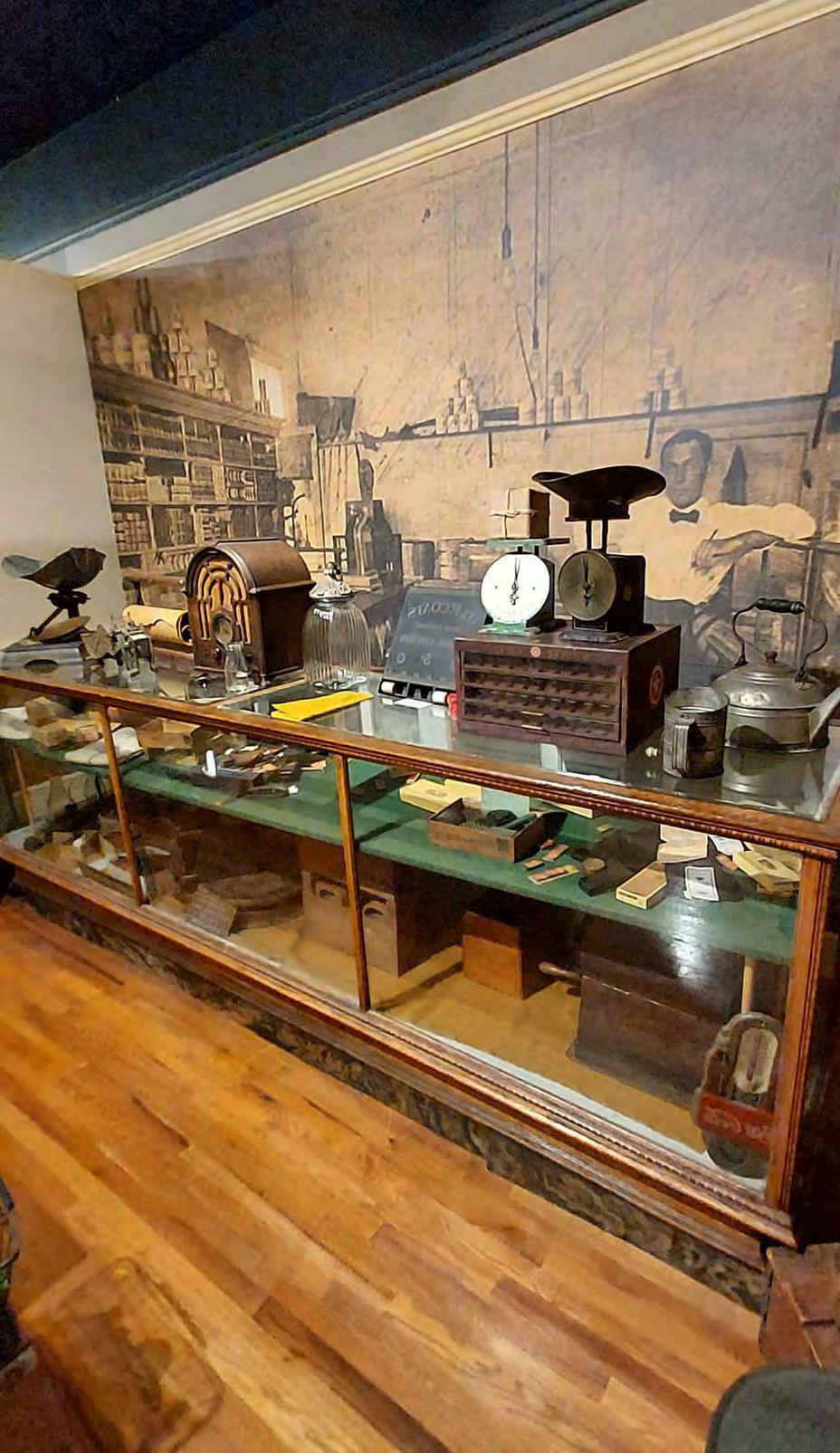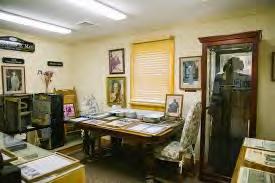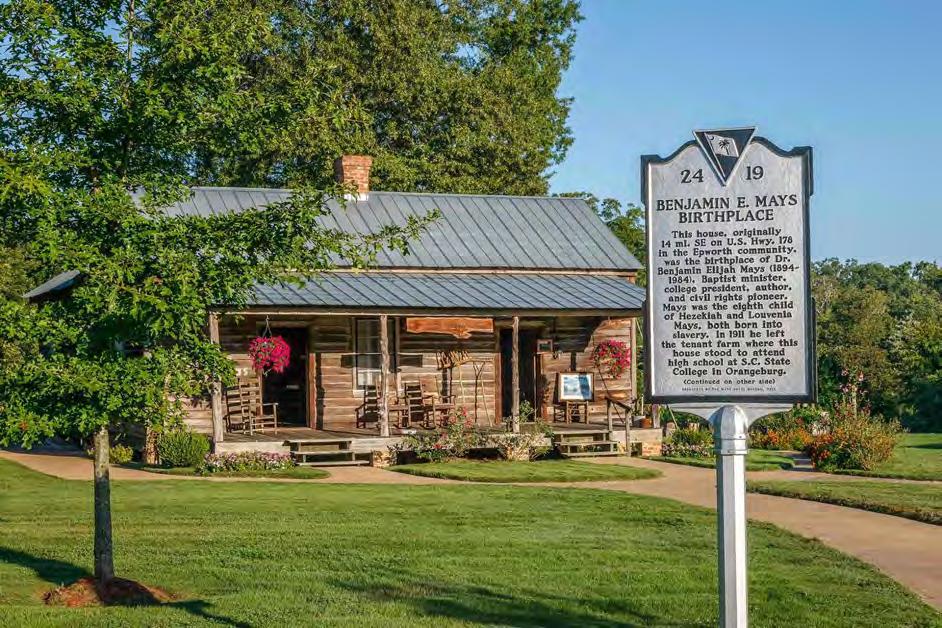
14 minute read
It has been my honor and privilege to serve
I have just one minute, Only sixty seconds in it, Forced upon me—can’t refuse it, Didn’t seek it, didn’t choose it, But it’s up to me to use it. I must suffer if I lose it, Give account if I abuse it. Just a tiny little minute - But eternity is in it. Often quoted by Dr. Benjamin Elijah Mays
Tens of thousands of visitors have come to the Mays Site in the past decade. They have experienced the life and legacy of Dr. Mays through our Living History, Museum, and through Research. Visitors experience 20th century American life with the replica of a 1900’s era tenant farm, the reality of late 20th century education when they enter the one-room Burns-Springs Schoolhouse, and gain a deep appreciation for the life of Dr. Benjamin E. Mays by viewing the many photographs and accompanying wall narrative in the museum explaining key elements of his life. The Mays Site is also used by educators, students, and others to research the life of Dr. Benjamin E. Mays.
Advertisement
LETTER FROM THE DIRECTOR
When the GLEAMNS Dr. Benjamin E. Mays Historical Preservation Site opened its doors more than a decade ago our goals were to focus on four things: Marketing and advertising, site maintenance, site expansion, and erecting a statue of Dr. Mays to serve as the centerpiece of the Site. All of these goals have been achieved in whole or in part.
Our vision for the GLEAMNS Dr. Benjamin E. Mays Historical Preservation Site was that of a vibrant center with a local, state, and national reputation for educating people about the extraordinary and legendary life of Dr. Benjamin E. Mays. The primary mission of the Mays Site is now to execute this vision. This mission of education and information is accomplished through three platforms: Living History, the Museum, and Research. This education focuses on how a son of a former slave, who became a tenant farmer, summoned the inner will and drive to obtain an education in spite of his early environment of poverty, Jim Crow segregation, racial discrimination and violence, and an unsupportive father. Two quotes of Dr. Mays come to mind as I reflect upon his life and the obstacles that he overcame, and the decade of obstacles that the historical preservation site bearing his name has overcome,
“It is not your environment, it is you- the quality of your mind, the integrity of your soul and the determination of your will that will decide your future and shape your life.”
“You are what you aspire to be, and not what you are now, you are what you do with your mind, and you are what you do with your youth.” It has been my honor and privilege to serve as the director for the past five years. I am thankful for the outpouring of community, state, and national support that the Mays Site has received during my tenure here. I extend my heartfelt appreciation to Dr. Joseph Patten (former CEO of GLEAMNS Human Resource Commission) and Mr. Loy Sartin (former director of the Mays Site) for their vision and tireless commitment to the work of curating the Site. To Mrs. Betty Boles (GLEAMNS Board of Commissioners, Chair) and Mrs. Shunna Vance Jeter (GLEAMNS Chief Executive Officer) for their leadership and commitments that make it possible to perform the necessary work of the Mays Site. To the many community partners who have supported the Mays Site for more than a decade.
As we continue the work of sharing the life and legacy of Dr. Benjamin E. Mays we are mindful of his admonition concerning the stewardship of time. The poem, Life is Just A Minute, was often quoted by Dr. Mays as a reminder through recitation that eternity is in our usage of time.
Lord, that I might find favor in thy sight through the years to come as I continue my service as the Director of the GLEAMNS Dr. Benjamin E. Mays Historical Preservation Site.
In His Service,

Christopher B. Thomas, Director GLEAMNS Dr. Benjamin E. Mays Historical Preservation Site
REMEMBERING
DR. BENJAMIN E. MAYS’S LEGACY

So said Ambassador Andrew Young as he spoke at the dedication of the Benjamin E. Mays Historical Preservation Site in Greenwood, South Carolina on April 26, 2011.
MARIAN WRIGHT EDELMAN
FOUNDER AND PRESIDENT EMERITA CHILDREN’S DEFENSE FUND
DR. BENJAMIN ELIJAH MAYS, WHO WAS BORN IN 1894 TO FORMER SLAVES,
was an adviser to Presidents, mentor of mentors like Dr. Martin Luther King, Jr., lauded preacher and scholar, advocate for social justice, and the president of Morehouse College from 1940 to 1967. He was a remarkable man and role model for thousands of students who entered the doors of Morehouse, Spelman College, Atlanta University, Clark and Morris Brown Colleges, and the Interdenominational Theological Seminary, the schools that constituted the broader Atlanta University Center of Black higher education.
Ramrod straight of posture, unwaveringly principled and caring, keenly intelligent and elegant in speech, Dr. Mays was one of the most important people to me during my college years at Spelman. Throughout my life he inspired me with a passion for excellence and service. The Mays Historical Site, which includes a museum, a 19th century one-room Black schoolhouse, and the simple log cabin that was Dr. Mays’s birthplace and childhood home, is a long overdue recognition of him by his native state, South Carolina.
One of Dr. Mays’s earliest childhood memories was of the armed White mob that came to his home during an 1898 riot and forced his father to bow before them at gunpoint. Eight other Black citizens, including Dr. Mays’s cousin, were murdered. Dr. Mays understood early on that the way to escape the violence, discrimination, and poverty of his rural Southern community would be through education. After graduating as valedictorian from the high school department of South Carolina State College at age 22, he went on to graduate with honors from Bates College in Maine. He went on to Atlanta, where he pastored Shiloh Baptist Church and was recruited to serve as a math instructor and debate coach at Morehouse. After returning to school to earn a Ph.D. in Religion from the University of Chicago, Dr. Mays was appointed dean of the School of Religion at Howard University in 1934, and served there until assuming the presidency of Morehouse.
I first met Dr. Mays in 1953 when I was thirteen years old and he came to stay at my house. Daddy had invited him to speak at our church, and because there were no hotels where Black visitors could stay in my Southern town, the pastor and parishioners always provided hospitality to strangers great and humble. Later, I heard and saw Dr. Mays and his beautiful wife Sadie often at Spelman or on Morehouse’s campus. Students were regularly invited to their house, and I was one of eight very lucky Spelman students privileged to sing with eight Morehouse students at Morehouse’s 9:00 a.m. Sunday morning chapel services in Sale Hall, where I heard Dr. Mays and other speakers from Morehouse and the outside world every week. Students lovingly imitated Dr. Mays’s words and mannerisms and hungrily internalized his unerring belief that we were God’s instruments for transforming the world.
the one who we looked up to most. He inspired and taught us and stood by us when we challenged Atlanta’s racial discrimination. Some of his teachings I wrote in my college diary. Others I internalized and, like many others who heard him frequently, I shared his words with others. I especially remember his oft-repeated “God’s Minute” from an anonymous sage:
I have just one minute Only sixty seconds in it, Forced upon me—can’t refuse it Didn’t seek it, didn’t choose it, But it’s up to me to use it. I must suffer if I lose it, Give account if I abuse it. Just a tiny little minute But eternity is in it.
Dr. Mays also warned “the tragedy of life is often not in our failure, but rather in our complacency; not in our doing too much, but rather in our doing too little; not in our living above our ability, but rather in our living below our capacities.” When Morehouse College bade Dr. King farewell after his assassination at a service on the grassy rectangle connecting Atlanta University with Morehouse, where I stood with thousands of others who had marched behind his simple mule-driven cortege, Dr. Mays movingly saluted his former student, fellow freedom fighter, and servant of God with Ralph Waldo Emerson’s words: “See how the masses of men worry themselves into nameless graves, while here and there a great unselfish soul forgets himself into immortality.”

How many high school and college students today are urged to follow intrinsic values rather than extrinsic success? Dr. Mays was a great unselfish soul who through the countless young people he inspired lives on. I am grateful a new generation will now be able to visit his childhood home and learn about Dr. Benjamin E. Mays’s life and legacy.
Marian Wright Edelman is an activist for children’s rights, and the founder and president emerita of the Children’s Defense Fund (CDF).
Original published on https://www.childrensdefense.org/child-watch-columns/ health/2011/remembering-dr-benjamin-e-mayss-legacy/, June 3, 2011
Saving, Sharing, & Celebrating Greenwood History Open Wednesdays - Saturdays 10:00 am - 5:00 pm www.greenwoodmuseum.org 864-229-7093


Rev. Christopher B. Thomas

With its annual Governor’s Awards in the Humanities, the Board of South Carolina Humanities has long recognized established leaders who have made enormous contributions to the state and nation in educational, cultural, and community-building roles. In 2018, SC Humanities has established a new award to be presented at the Governor’s Awards in the Humanities luncheon and ceremony in October. The Fresh Voices in the Humanities Award has recognized individuals who are working in unique and innovative ways to use culture and history to bring people together, but whose efforts have gone relatively unnoticed beyond their own community. The 2021 recipients of the Fresh Voices in the Humanities Awards are Dr. Lydia Brandt, Associate Professor of architecture, American art, and theories and methods of historic preservation at the University of South Carolina; Tamara Herring, Executive Director of the Morris Center for Lowcountry Heritage; The Rev. Christopher B. Thomas, Director of the Benjamin E. Mays Historical Preservation Site; and Dr. Kasie Whitener, novelist, business owner, and instructor at the University of South Carolina. Lucas McMillan, Lander University dean of the college of behavioral and social sciences, nominated Thomas. In his nomination letter, McMillan cites Thomas’ efforts to provide innovative programming and advocacy for people of all ages to learn about Mays, renewing “attention to this important figure in S.C. history.” “Chris is a humble man and prefers co-teaching or panel discussions, but it is always clear that he is a gifted storyteller and a fountain of knowledge about Dr. Mays,” McMillan wrote in an email to the IndexJournal. Alice Taylor-Colbert of Greenwood joined McMillan in submitting a letter of support for Thomas’ nomination. Taylor-Colbert, a consultant and retired history professor and dean, said Thomas has been a presenter for a series at Lander University on race and identity, which was funded by South Carolina Humanities. Taylor-Colbert is also a development and special initiatives officer for South Carolina Humanities. “He (Christopher Thomas) has studied Dr. Mays so thoroughly and provided such insight,” Taylor-Colbert said of that dialogue series. “... His ability to work with students of all ages is very, very important. As an educator, he’s going to have an impact on the Greenwood community for many, many years.”



HISTORY

OF THE BENJAMIN E. MAYS HISTORIC SITE
The site had its earliest beginnings with the acquisition of Dr. Benjamin E. Mays’ birth home in 2004 when it was moved from its original location on US-178 in the Epworth Community.
THE HOME HAD BEEN ON SOUTH CAROLINA’S LIST OF MOST ENDANGERED AFRICANAMERICAN STRUCTURES.
The family who owned the home refused to release it. They were using it as a barn for hay storage and it was beginning to deteriorate badly. In 2002 a meeting was held in Greenwood to discuss acquisition of the home. It included Dr. Larry Jackson, president of Lander University; Dr. Joseph Patton, CEO of GLEAMNS; Mr. Frank Wideman, president of the Self Family Foundation; County Councilman, Mr. Gonza Bryant; Mr. Steve Brown, City Manager; and Mr. Kenneth Driggers and Ms. Jennifer Satterthwaite of the S.C. Palmetto Conservation Foundation. After the meeting, Mrs. Griffith was approached and she agreed to sell the home for $4,000 and required that it be moved. For context, this culminated a more than twenty- year effort to secure the home which began in November 1981 at the Mays Crossroads Dedication in Epworth. During the dedication, Dr. Mays visited his home a few feet away with Congressman William Jennings Bryan Dorn and Dr. Larry Jackson of Lander University and assured them that the home was indeed his birth place. (Seven years prior to this event in the summer of 1974 during the filming of Born to Rebel, Dr. Mays is seen standing in front of the home declaring that “this is where I first saw the light of the day, just before the turn of the century.”)
It was at the Mays Crossroads Dedication that Dr. Mays’ confided to his secretary, Mrs. Sally Warner, that “he wished that his birth home could be saved.”
In late 2004, Dr. Mays’ birth home was moved to vacant land on the GLEAMNS campus at the insistence of Dr. Patton because of the historical nature and meaning of the campus to African Americans in Greenwood. The campus encompasses the old Brewer School which was founded in 1872 as the Brewer Industrial Normal School for Colored. It served as a black high school as far back as the 1920’s up until integration around 1971 at which time the school was converted to a Greenwood District 50 middle school. The campus also encompasses the old Brewer Hospital for blacks during segregation as well as the building which housed the black nurses. The Brewer Lab trained about seventy-five percent of the black nurses in South Carolina.
the Benjamin E. Mays Historic Site and the Mays Museum (the barn) was built around 2006. Around this time the sidewalks were poured and a wrought iron fence and electronic access gate were placed around the site property. However, the school, museum, and birth home sat empty until 2010. In the fall of 2009 Mr. Loy Sartin, who had retired from a 29-year Air Force career and a 11-year career with Greenwood School District 50, met with Dr. Joe Patton and volunteered to set up the historic site.
During the 13- month period from March 2010 – April 2011, Mr. Sartin worked relentlessly and tirelessly to completely set up the site which included furnishing the birth home, schoolhouse, and the Mays Museum.
In addition, he planted the first garden and cotton field as well as planted three oak trees, shrubs around the house and school, and set up the yard with a wash pot and tubs for cleaning clothes. He also built a well from very old lumber and a cedar post clothesline. On April 26, 2011, the Benjamin E. Mays Historic Site was dedicated. A stage and tent were set up in the parking lot and the dedication ceremony drew over 1000 people from across the nation. Television and radio stations descended on the site to record the magnificent event. The Morehouse Glee Club Quartet provided music while the speakers, among others, included Dr. Mays’ last niece, Mrs. Bernice Mays Perkins of Cleveland, OH; Dr. Samuel Dubois Cook who eulogized Dr. Mays on Mar 31, 1984; and Keynote Speaker, Ambassador Andrew Young of Atlanta, GA.
After the dedication, Dr. Joseph Patton continued to provide outstanding direction for the Mays Historic Site until his retirement in 2016. Mr. Sartin continued to serve the Site as a volunteer and eventually as a paid director. Up until his retirement in 2017, he conducted hundreds of tours annually and gave an untold number of Mays Site presentations at schools, universities and churches in South Carolina and Georgia. He continues to serve voluntarily giving tours when needed, maintaining the flower beds, and planting/maintaining the annual garden and educational cotton field.










